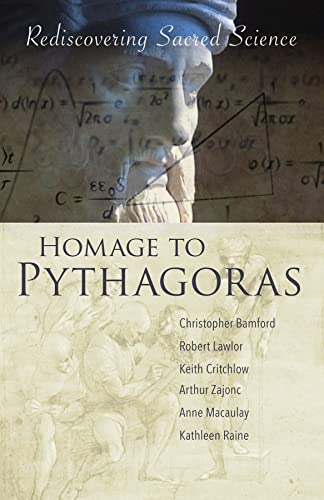Form - Number - Geometry - Architecture - Light - Color - Music - Poetry
"All such disciplines, theories, and scientific investigations as truly invigorate the eye of the soul, and purify the intellect from blindness introduced by studies of a different kind, so as to enable it to perceive the true principles and causes of the universe, were unfolded by Pythagoras to the Greeks." --
Iamblichus,
Life of PythagorasHomage to Pythagoras collects essential writings by authors at the leading edge of the sacred sciences today. Each chapter--scholarly homages to the Pythagorean perspective--confirms the continuing interest in Pythagoras' philosophy as a living reality. These authors provide a major addition to the field of Pythagorean studies and traditional mathematics.
Christopher Bamford (1943-2022) was born in Cardiff, South Wales, and lived for a while in Hungary and then in Scotland. He studied as an undergraduate at Trinity University in Dublin and earned his master's degree at the Annenberg School for Communication, University of Pennsylvania. For nearly thirty years, he was Editor in Chief at SteinerBooks (Anthroposophic Press) and its imprints. A Fellow of the Lindisfarne Association, he lectured, taught, and wrote widely on Western spiritual and esoteric traditions. His books include a selection of his numerous introductions, Encountering Rudolf Steiner: Introductions to Essential Works (2022); Healing Madonnas: Exploring the Sequence of Madonna Images Created by Rudolf Steiner and Felix Peipers for Use in Therapy and Meditation (2017); An Endless Trace: The Passionate Pursuit of Wisdom in the West (2003); and The Voice of the Eagle: The Heart of Celtic Christianity (1990). He also translated and edited numerous books, including Homage to Pythagoras: Rediscovering Sacred Science (2001); The Noble Traveller: The Life and Writings of O. V. de L. Milosz (1984); and Celtic Christianity: Ecology and Holiness (1982). Essays by Mr. Bamford are included in The Best Spiritual Writing 2000 ("In the Presence of Death") and The Best American Spiritual Writing 2005 ("The Gift of the Call"). Christopher passed over the threshold on May 13, 2022, at his Mt. Washington, Massachusetts home.
Kathleen Raine (1908-2003) graduated from Cambridge University in 1929. She became one of English literature's most remarkable twentyth-century practitioners. Although she considered herself primarily a poet, she was also a prolific writer of prose, an astute critic, and a distinguished scholar. Her poems and essays assert that true poetry is an expression of the spirit, the unfolding of a reality often hidden by the material appearance of things. Raine wrote a three-part autobiography (1973-1977), founded the magazine
Temenos in 1981 to articulate her views, and in 1990 established the Temenos Academy of Integral Studies, a teaching academy that stressed a multistranded universalist philosophy. A professor at Cambridge and the author of a number of scholarly books, she was an expert on Coleridge, Blake, and Yeats.
Arthur Zajonc, Ph.D., is the Andrew Mellon professor of physics and interdisciplinary studies at Amherst College and is currently the director of the Academic Program of the Center for Contemplative Mind, an organization of 1500 academics supporting the appropriate inclusion of contemplative practice in higher education. Dr. Zajonc is the former General Secretary of the Anthroposophical Society in America, a cofounder of the Kira Institute, past President of the Lindisfarne Association, and a senior program director at the Fetzer Institute. He has served as scientific coordinator and editor for several dialogues with the Dalai Lama:
The New Physics and Cosmology, held in 1997 and published in 2004, and "The Nature of Matter, the Nature of Life" (2002, unpublished). He was also moderator for the 2003 MIT dialogue, published as
The Dalai Lama at MIT (2006). Dr. Zajonc is the author
Catching the Light (1993, 1995), coauthor of
The Quantum Challenge (2nd ed. 2005), and coeditor of
Goethe's Way of Science (1998).
Anne Macaulay (1921-1998) lived in Scotland where, for many years, she studied the origins of the alphabet, the history of the guitar, the figure of Apollo, and other mysteries surrounding Pythagoreanism. She settled in Balerno near Edinburgh and traveled widely, surveying megalithic sites around the world. In 1994, she was awarded an Honorary Fellowship by the University of Edinburgh. Mrs. Macaulay lectured at RILKO (Research into Lost Knowledge Orga-nization) and was a trustee of the Salisbury Center in Edinburgh.
Prof.
Keith Critchlow (1933-2020) was a well-known lecturer and author and a founding member of Research Into Lost Knowledge Organization (RILKO), a founding member and Director of Studies of Kairos, and a founding member and President of the Temenos Academy. He was Professor Emeritus and founder of the Visual Islamic and Traditional Arts Programme at the Royal College of Art, now the Prince's School of Traditional Arts. Trained as a painter, Critchlow discovered geometry intuitively. A period of intensive geometric practice (and work with Buckminster Fuller) led him to the recognition that the universal principles of geometry are revealed and confirmed both by the area of design where art and mathematics meet and in the study of nature and ancient and medieval sacred cosmological stone, temple, cathedral, and mosque architectures. Keith Critchlow had been a senior lecturer at the Architectural Association in London, and taught Islamic Art at the Royal College of Art. He also participated as geometer in various sacred architectural projects. His books include
Islamic Patterns: An Analytical and Cosmological Approach (1999);
Time Stands Still: New Light on Megalithic Science (2007); and
The Hidden Geometry of Flowers: Living Rhythms, Form, and Number (2011).
